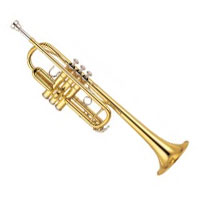
Whether your child has signed up for the school band or you’ve been inspired to pick up a brass instrument after listening to jazz music, you may be unsure where to start.
The brass family ranges from higher-pitched trumpets to lower-pitched tubas, all of which are made from a brass alloy. These instruments all have a mouthpiece that you blow into and vibrate with your lips to generate a sound, as well as extensive tubing and valves.
On occasion, the saxophone is grouped into the brass family due to its body composition. Yet, it uses a single reed rather than a mouthpiece and is played similarly to the clarinet. It’s generally considered a woodwind instrument.
Brass instruments cross a number of genres, from orchestral music to jazz and marching band numbers, as well as ska and other popular styles. If you’re just getting started or want to upgrade to a better instrument, here’s what you should consider.
Which Brass Instrument Should I Play?
To narrow down your search, think about the following factors:
- What kind of music you listen to: Do you primarily listen to jazz and big-band music or classical? Think about the repertoire you would like to learn and which ensembles you would be interested in joining.
- Groups and repertoire: Brass instruments are integral to multiple ensembles, yet the trumpet and French horn tend to see more solo repertoire. The trombone and tuba are frequently ensemble instruments, filling in tenor and bass voices respectively.
- What you might be able to play: While all players learn to use circular breathing, trombones require regular reaching. For a tuba, you need to be prepared to support a significant amount of weight and larger instruments require more air.
- How much you’re willing to spend: Smaller instruments tend to cost less than larger ones. For serious players, you may need to purchase multiple instruments, including B-flat and C trumpets or an alto and tenor trombone.
- Player level: Certain beginner brass instruments use a plastic design for practice. As your skills improve, you’ll transition to brass.
Standard Instruments of the Brass Family
For a general rundown of common brass instruments:
- Trumpet: This is the smallest and highest-pitched brass instrument. Therefore, solos are more prominent in repertoires, no matter the genre. The modern instrument features a thin pipe curled multiple times over and equipped with three valves.
- French Horn: Designed to rest in the player’s lap, the French horn features tubing rolled into a circular shape and “keyed” valves. An alto voice in ensembles, the French horn assumes both melodic and harmony roles. In terms of learning the instrument, two clefs are used, each with different transpositions. For marching bands, the mellophone covers a similar range of pitches but is more easily carried.
- Trombone: Players move a U-shaped slide around to hit various pitches. Certain instruments may also be equipped with a valve. In orchestras, the trombone section includes three differently pitched instruments: alto, tenor and bass.
- Tuba: Known for a deeper range of pitches and similar sounds, tubas round out the brass section across ensembles. Yet for marching band, students tend to play the sousaphone, which wraps around their body rather than supported by their lap.
Metal Quality and Tone
More advanced players should think about the metal that makes up your brass instrument, which can affect vibrations and tone quality. While brass is a mixture of copper and zinc, alloys can vary:
- Gold brass has a higher percentage of copper and a more expansive tone
- Yellow brass has a lower percentage of copper and a brighter tone
- White brass adds nickel for improved corrosion resistance and has a deeper tone
Whether you’re renting an instrument for school, interested in purchasing something more advanced or want to try out the trumpet, DuBaldo Music Center covers the full span of brass instruments! To learn more, contact us today.
